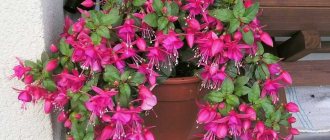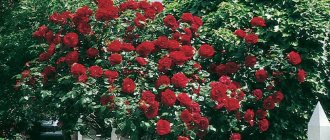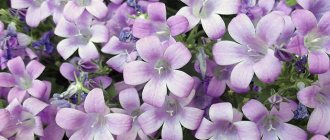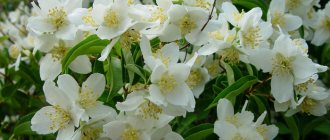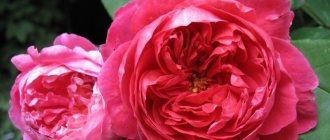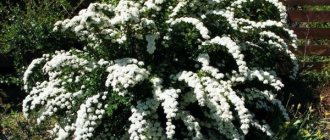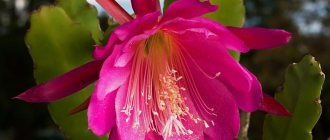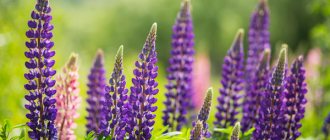The evergreen plant Cryptomeria is confused with Japanese cedar. It has no relation to the Pine family, as it belongs to the Cypress family. The similarity is due to the majesty and unusually large size of adult specimens.
Cryptomeria in single plantings is found only in China and several archipelagos of neighboring Japan. In Japan, the coniferous giant is called sugu, and in China - shan.
Botanical properties of cryptomeria
- In most varieties, the crown has the shape of a pyramid, the needles are bluish-green, and in winter they can change color to a darker one.
- The height of the trunk varies from 1.5 to 50 meters, the crown is usually dense, narrowed from the sides.
- The bark is brown with shades of red, with pronounced fibers.
- The leaves are spiral-shaped, greenish, slightly curved at the base.
- The cones are spherical and can reach 2-3 centimeters in diameter.
- The wood is light, slightly rotting, but very soft. It is because of this factor that it is not used in any area other than decoration.
Garden forms
There are more than a couple hundred species of this conifer. An incredibly beautiful monoecious plant, the pyramidal crown of which has a shape reminiscent of a pin, which looks very impressive and elegant. All species of this conifer enjoy moist, acidic soil and plenty of sunlight. They are quite easy to care for.
GARDEN REVIEW My GARDEN IS DECORATED BY JAPANESE CRYPTOMERIA! Rasen, Serama, Glaboza ANAS. Japanese cedar
Types of cryptomeria
Cryptomeria attracts attention with its genuine beauty. It is not for nothing that it began to be cultivated in southern and central Europe in the mid-19th century. In the 21st century, scientists have developed many varieties of Japanese cryptomeria, differing in the color of the needles, the height and diameter of the trunk, and resistance to weather conditions.
- Сryptomeria japonica. Sharp needle leaves that change color from bright green to bronze depending on the air temperature.
- Elegans Compacta is a subspecies of Japanese Cryptomeria, the name speaks for itself: it is distinguished by its smaller size. The needles change color depending on the time of year.
- Elegans Viridis - the crown has the shape of a wide cone, the branches are highly branched. Suitable for planting in mid-latitudes, including Russia.
- Cristata - branches are more compressed towards each other, grows quite quickly.
- Vilmoriniana - the crown is more rounded, has slow growth.
- Vandai-sugi is a dwarf tree, maximum two meters in height, which has gained popularity in European countries. It grows small but fluffy.
Elegans viridis
The crown shape of this variety is wide and cone-shaped, rather low. The needles are dark green in color, acquiring a soft waxy tint up close, like the leaves of succulents. The bark is red, dense and thick. The variety is primarily distinguished by its resistance to winters and off-seasons in central Russia: thanks to this, gardeners successfully grow it in open ground. The needles acquire brownish-reddish shades in the winter. You can see what the variety Cryptomeria Elegans Viridis looks like in the photo below:
Cryptomeria japonica elegans viridis
The use of “Japanese cedar” in landscape design
Various varieties of cryptomeria are used for landscaping parks, and are also used as forest shelterbelts.
Some gardeners grow this ornamental tree right at home, in a winter garden or on an insulated balcony. As a rule, dwarf varieties are chosen for such purposes and planted in small tubs. To maintain growth, it is necessary to occasionally replant cryptomeria.
In addition to its excellent decorative properties, it can change the microclimate of the room in a positive direction (due to the release of essential oils that can destroy harmful microorganisms).
Вandai-sugi
First of all, the variety was bred for compact garden compositions. The crown is quite small, the coniferous leaves are spread out and give some fluffiness to the cryptomeria, their color is soft emerald to jadeite and jade green. The shoots are located more chaotically and create the feeling of a tiny bonsai tree - although the crop can also grow in the garden. In the photo below is the variety Cryptomeria Vandai-sugi:
Cryptomeria japonica Вandai-sugi
Care for home cryptomeria
- The plant is light-loving, but you should not place it under direct ultraviolet rays; the most suitable option would be partial shade.
- In summer, it would be better to place the tree outside; if you do not have this opportunity, then do not forget to ventilate the room in which the tree is located. It does not do well in stagnant air.
- The optimal temperature for the plant is from 19 to 25C in summer and from 14 to 20C in winter.
- You need to water less often, only when the top layer of soil dries out. Excess moisture can lead to rotting of the root system, and then the final death of the plant. But you need to spray the leaves 2 times a day with plain water at a temperature of 20-26 degrees. If you ignore this point, the needles from your tree will gradually fall off and lose their natural color.
- Feeding only needs to be done a couple of times throughout the year, preferably from June to August. Use universal mineral fertilizers diluted in water.
Shchitovka
Another scourge of cryptomeria is the scale insect. get rid of it, as well as spider mites, with the help of broad-spectrum insecticides, or you can thoroughly wash the plant several times with soap suds at intervals of two to three days.
If you paid attention to all the branches, and the plant is small enough, then after three procedures you will not find any traces of the scale insect. Excessive moistening of the earthen clod is also contraindicated - remember that the tree is a coniferous tree, and therefore
is not able to quickly evaporate large amounts of moisture from the ground. Root rot and fungus lead to withering, yellowing and death of the bush. The main thing is to understand in time that the plant is suffering from excess water, carefully remove the affected areas and treat with fungicidal preparations - phytosporin, for example. The soil must be changed, and the container must be spilled with a solution of potassium permanganate and fungicide.
Transplantation and propagation of cryptomeria
In the first years after planting, the plant must be replanted annually, and this must be done with extreme caution. Only slightly change the dimensions of the next pot, as the plant grows quickly. Or you can get by with just transshipment, then the danger of damaging the sensitive root system disappears.
Propagating cryptomeria at home with seeds is problematic; sprouts sprout only after 6-8 weeks, and you are unlikely to be able to grow a truly decorative specimen. It is better to use cuttings: carefully cut the cutting and place it in water. When small roots appear, the tree can be planted in the ground.
How to propagate a plant
Cryptomeria reproduces:
- seeds;
- simple cuttings;
- layering.
It is difficult to propagate and root the plant at home. The whole procedure is complex, and the outcome may be negative. Therefore, layering is used in relation to those plantings that grow outside the house:
- Thin branches are selected at the bottom of the trunk;
- inclined to the ground;
- sprinkle with earth;
- secured with a “hairpin”;
- monitor soil moisture;
After the root system has developed well and strengthened, it is separated from the large plant.
And yet, the most acceptable method is propagation by cuttings. The procedure should be done at the end of summer.
Process:
- for cuttings we take the upper part of the shoots, remove the needles at the bottom of the cut off shoot;
- place the root formation stimulator dissolved in water for 24 hours;
- after time, the cuttings are buried in a soil mixture of peat and sand, with the same proportion;
- If cuttings are not carried out in greenhouses, then we cover them with film and create a mini-greenhouse.
Rooting of the plant can last up to two months. It is necessary to monitor soil moisture.
How to transplant
It is not advisable to replant open ground plants.
Transplantation is possible only for cryptomeria grown in pots. The age of the seedling for transplantation is from 2 to 3 years.
The rules are simple:
- Containers are selected larger in diameter, those in which Cryptomeria domestica grows.
- Be sure to use drainage and a soil mixture of peat and sand.
- We simply transfer the tree with a lump of earth into a prepared pot and add the required amount of earth.
- We compact it so that there are no air gaps and the roots adhere tightly to the ground.
- Water abundantly and monitor the moisture content of the earth so that it does not dry out.
Symbolism
Big sugi from Kayano
Sugi Avenue at Togakushi Temple in Nagano
Cryptomeria japonica
—MHNT
Sugi is the national tree of Japan, usually planted around temples and shrines, with many very impressive trees planted centuries ago. Sargent (1894, Forest Flora of Japan
listen)) recorded an instance of
a daimyo
(feudal lord) who was too poor to donate a stone lantern at the funeral
of shogun
Tokugawa Ieyasu (1543–1616) in Nikko Toshō-gu, but requested instead to be able to plant a Sugi alley so that "future visitors can be protected from the scorching sun." The proposal was accepted; Nikko's Cedar Avenue, which still exists today, is over 65 km (40 mi) long, and "unmatched in its stately splendor".
Jomon Sugi
(縄文杉) large Cryptomeria tree is located at Yaku, a UNESCO World Heritage Site, in Japan. It is the oldest and largest of the old-growth Cryptomeria trees on the island, and is estimated to be between 2,170 and 7,200 years old.
Tree Facts
These cypress relatives have a lifespan of more than 1,000 years. In Japan, the tree is a national symbol and is included in the state register of cultural property. This species has long been planted near shrines and temples, tied around ropes of rice straw - shimenawa, signs of divine affiliation. On the island of Yakushima, cryptomeria forests have received the status of national parks and are protected. Many trees growing there are over 2,000 years old, and the main local attraction, the symbol of the island - Jomon-sugi - has crossed the threshold of 7,300 years.
In the spring, residents of cities close to cryptomeria plantations are forced not only to enjoy their majestic view, but also to suffer from severe hay fever. Flowering trees fill the air with pungent pollen, which makes your eyes water, your nose itch, and your throat sore. Even gauze bandages help little. Children and people with respiratory system diseases suffer more than others. It’s interesting that flowering conifers hardly cause any problems for visitors.
Sugu wood has a light brown color and a clear contrasting pattern due to the dark resin filling the parenchyma cells. The surface of the massif on sections is lined with dark strokes and flickers slightly in bright light. The wood fibers are straight, the density is about 400 kg/cub.m. Oil content prevents the material from rotting. Cryptomeria lends itself well to manual and mechanical processing and holds nails. It is suitable for the construction of wooden frames, building walls, gates, bulky furniture, and various carpentry products. In the mid-20th century, due to active logging, tree populations in Japan and China were greatly reduced.
Diseases
This culture has no infectious diseases. He has excellent immunity. Pests do not touch it. With poor care, scale insects and spider mites can still cause harm. Therefore, it is advisable not to violate the rules of agricultural technology. Inspect the plant’s needles and branches more often.
If the plant is affected, it should be treated with insecticides.
Follow the basic rules of growing a crop and then the plant will delight you for many years with its aroma and decorative effect.

